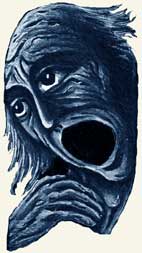'The
dust lies where it was, it cannot offer any answer to its sad soul, any
help or comfort. Its head is split, its hands disjointed, its jaws agape,
its gums torn, its fingers have dropped off.'![]() While the soul returns to torment, the body is left in its own hell -
its immobile helplessness and its inevitable decay.
While the soul returns to torment, the body is left in its own hell -
its immobile helplessness and its inevitable decay.

The image of
the evil body being torn up by worms is used three times![]() ,
twice directly after an allusion to the soul's destiny in hell.
,
twice directly after an allusion to the soul's destiny in hell.
Worms also appear in the Visio Pauli were they recurrently form
a part of torture-descriptions in hell: 'And I saw another multitude of
pits in the same place, and in the midst of it a river full of a multitude
of men and women, and worms consumed them.'![]() But this idea is not original in the Visio. In the Apocalypse
of Peter,for example, the devouring worms occur twice:' And other
men and women were burning up to the middle and were cast into a dark
place and were beaten by evil spirits, and their inwards were eaten by
restless worms:...'
But this idea is not original in the Visio. In the Apocalypse
of Peter,for example, the devouring worms occur twice:' And other
men and women were burning up to the middle and were cast into a dark
place and were beaten by evil spirits, and their inwards were eaten by
restless worms:...'![]()
Back in Soul
and Body I, the greatest of the worms is called 'Gifer', 'Greed' (116a),
and all the worms are described as 'gifre ond grædige', 'greedy
and hungry'(74a). H.T. Keenan![]() brings to our attention, that this formula is applied to hell in other
poems as well. In Genesis (793a), hell is 'greedy and hungry', in Christ
and Satan (32a), the devil receives these attributes, while all devils
are meant in line 191a of the same poem. Keenan goes on to state that
'Greediness and swallowing are commonly associated
with hell
brings to our attention, that this formula is applied to hell in other
poems as well. In Genesis (793a), hell is 'greedy and hungry', in Christ
and Satan (32a), the devil receives these attributes, while all devils
are meant in line 191a of the same poem. Keenan goes on to state that
'Greediness and swallowing are commonly associated
with hell![]() ;
cf. the Hell-Mouth of OE iconography.'
;
cf. the Hell-Mouth of OE iconography.'![]()
Even though the body is never directly said to go to hell before Judgement Day, the allusions in this direction are strong enough to purport that it is already there.
| Address of the damned soul to its body |